
The school shark is a houndshark of the family Triakidae, and the only member of the genus Galeorhinus. Common names also include tope, tope shark, snapper shark, and soupfin shark. It is found worldwide in temperate seas at depths down to about 800 m (2,600 ft). It can grow to nearly 2 m long. It feeds both in midwater and near the seabed, and its reproduction is ovoviviparous. This shark is caught in fisheries for its flesh, its fins, and its liver, which has a very high vitamin A content. The IUCN has classified this species as critically endangered in its Red List of Threatened Species.
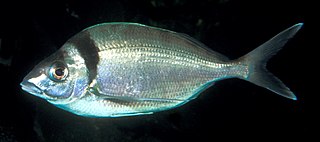
Nemadactylus macropterus, the tarakihi, jackass morwong or deep sea perch, is a species of marine ray-finned fish, traditionally regarded as belonging to the family Cheilodactylidae, the members of which are commonly known as morwongs. It is found in the south western Pacific Ocean, in Australia and New Zealand. Although there are records from the southern Indian Ocean and southwestern Atlantic, these may be due to misidentifications of similar species.
The spiny-back eel, Notacanthus sexspinis, is a deep-sea spiny eel of the genus Notacanthus, found in all the Southern Hemisphere oceans at depths between 500 and 1,000 m. The length of this fish is up to 60 cm (24 in).

The banded bellowsfish, banded yellowfish, banded snipefish, or bluebanded bellowsfish, is a species of fish of the family Macroramphosidae, found in southern oceans at depths of 35 to 1,000 m. Its length is up to 30 cm (12 in).
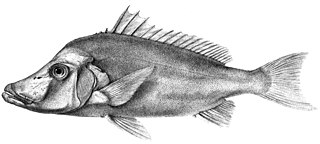
Paristiopterus labiosus, the giant boarfish, is a species of armorhead native to the coastal waters of southern Australia, and New Zealand. It occurs over the continental shelf at depths from 20 to 200 m. This species can reach a length of 100 cm (39 in). It is a commercially important species.
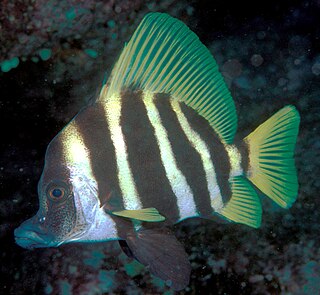
The striped boarfish, also known as whiskered boarfish, Japanese boarfish, sailfin armourhead or whiskered armorhead, is a species of marine ray-finned fish, an armourhead of the family Pentacerotidae, which is native to the Pacific Ocean from the Hawaiian Islands westward to the coast of Asia and Australia. This is a reef-dwelling fish found at depths between 18 and 193 m. It can reach a total length of 90 cm (35 in). It is currently the only known member of the genus Evistias.

Pentaceros richardsoni, the pelagic armourhead, Richardson's boarfish or southern boarfish, is a species of marine ray-finned fish, an armourhead from the family Pentacerotidae. It has a wide distribution in the oceans of the southern hemisphere. It is commercially important as a food fish.

The rubyfish, also known as the cosmopolitan rubyfish, red ruby or ruby rover, is a species of marine ray-finned fish, belonging to the family Emmelichthyidae, the rovers, bonnetmouths and rubyfishes. This species is found from the southeastern Atlantic Ocean off South Africa through the Indian Ocean to the southwestern Pacific Ocean around Australia and New Zealand. This species is commercially important.

Helicolenus percoides, the reef ocean perch, coral cod, coral perch, Jock Stewart, kuriarki, ocean perch, red gurnard perch, red gurnard scorpionfish, red ocean perch, red perch, red rock perch, scarpee or sea perch, is a species of marine ray-finned fish belonging to the subfamily Sebastinae, part of the family Scorpaenidae. It is found in the southwestern Pacific Ocean.

Latris lineata, the striped trumpeter, common trumpeter, copper moki, Hobart-town trumpeter, kokikohi, real trumpeter, Tasmanian striped trumpeter or Tasmanian trumpeter, is a species of marine ray-finned fish belonging to the family Latridae, the trumpeters. It is native to rocky reefs in the temperate oceans of the southern hemisphere.

The New Zealand eagle ray or Australian eagle ray is an eagle ray of the family Myliobatidae, found in bays, estuaries, and near rocky reefs around New Zealand and southern Australia on the inner continental shelf. It is a common species and the International Union for Conservation of Nature has assessed its conservation status as being of "least concern".

The blackspot shark is a small species of requiem shark in the family Carcharhinidae found in the tropical Indo-West Pacific Ocean between latitudes 24°N and 30°S, from the surface to a depth around 40 m (130 ft). Its length is a little under one meter (yard) and it is not considered to be dangerous to humans. It feeds mainly on fish, crustaceans, and squid. This shark is also caught in small-scale fisheries for human consumption.

The Australian angelshark is a species of angelshark, family Squatinidae, found in the subtropical waters of southern Australia from Western Australia to New South Wales between latitudes 18°S and 41°S, at depths down to 255 m (840 ft). Its length is up to 1.52 m (5 ft). Reproduction is ovoviviparous, with up to 20 pups in a litter.

Porgy is the common name in Australia for any fish which belongs to the family Sparidae. They are also called bream. Porgies live in shallow temperate marine waters and are bottom-dwelling carnivores. Most species possess grinding, molar-like teeth. They are often good eating fish, particularly the gilt-head bream and the dentex.
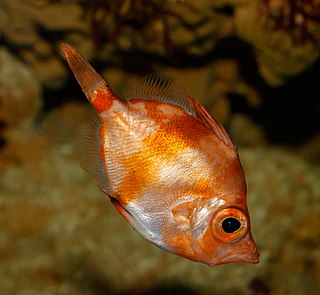
Capros, the boarfish or Zulu fish, is a monospecific genus of marine ray-finned fish belonging to the family Caproidae. Its only known species is Capros aper. The boarfish is found in the northeastern Atlantic Ocean and the Mediterranean.

The Australian blackspot shark or Coates's shark is a species of requiem shark found off northern Australia and possibly also off the coast of New Guinea. It belongs to a species complex of Blackspot sharks in the family Carcharhinidae. These sharks are not widely studied due to their cryptic nature, but there was a recent reclassification distinguishing it from the Whitecheek shark and the Blackspot Shark in 2012. Much of the existing literature predates this reclassification and groups the Australian blackspot shark with the aforementioned closely related species.
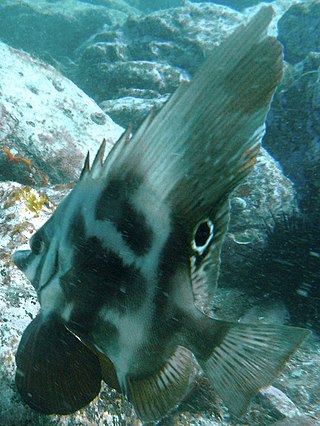
The short boarfish, also known as Hutchin's boarfish, is a species of marine ray-finned fish, an armourhead from the family Pentacerotidae. It is endemic to the southern coast of Western Australia. It is found on the continental shelf at depths from 10 to 80 m. This species grows to a total length of 34 centimetres (13 in), and is the only known member of its genus.
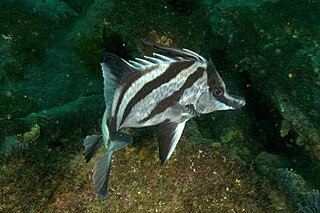
The longsnout boarfish is a species of marine ray-finned fish, an armourhead from the family Pentacerotidae. It is endemic to the temperate waters of the southern coast of Australia including around the island of Tasmania. It is found over the continental shelf at depths from 3 to 260 m, though usually at less than 40 m (130 ft). It is carnivorous and its diet consists mostly of polychaete worms, brittle stars, and brown algae. It is trawled throughout its range, though is not a commercially important species and catch rates are low. It is the only known member of its genus.
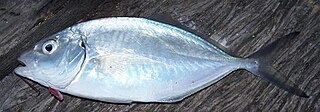
Silver trevally, Pseudocaranx georgianus, is a jack of the family Carangidae found around the coast of Australia and New Zealand.
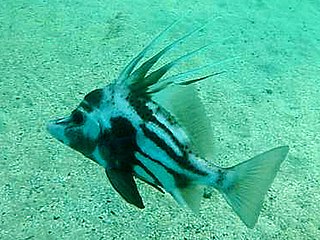
Paristiopterus gallipavo, the yellowspotted boarfish, brown-spotted boarfish, giant boarfish or yellow-spotted penfish, is a species of marine ray-finned fish, an armourhead from the family Pentacerotidae. It is a carnivorous species which is endemic to the temperate seas of southern Australia where its range extends from Carnarvon, Western Australia to the Investigator Strait in South Australia. It is found at depths down to 260 metres (850 ft) and it lives on the continental shelf or continental slope.



















